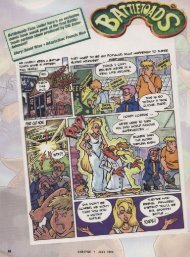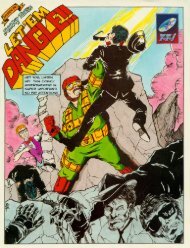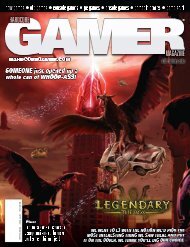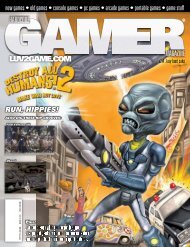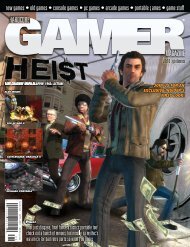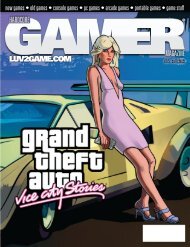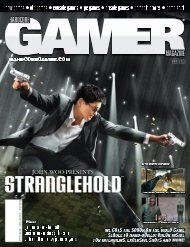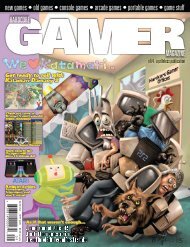Download - Defunct Games
Download - Defunct Games
Download - Defunct Games
Create successful ePaper yourself
Turn your PDF publications into a flip-book with our unique Google optimized e-Paper software.
Publisher: Idea Factory Genre(s): Turn-Based Strategy<br />
Developer: Aruze/Atlus/Idea Factory/Red Entertainment # of Players: 1<br />
Release Date: 9/21/2006 Category: Hey Kids Look It’s Yuri Hyuga<br />
Chaos Wars is sort of like the RPG equivalent of<br />
Namco x Capcom or Super Robot Wars, with the<br />
casts of the first two Shadow Hearts, Spectral<br />
Souls, Gungrave, and Growlanser all teaming up.<br />
The story involves a first-year student, Hyoma<br />
Kusaka, inadvertently fulfilling a prophecy<br />
about his family when he opens a magical gate.<br />
Strategy-themed combat on a host of different<br />
worlds ensues, as does a ton of text.<br />
Fortunately, Chaos Wars is a fairly intuitive<br />
turn-based strategy game, so playing it doesn’t<br />
require any real fluency in Japanese. It’s<br />
actually very much like Phantom Brave; the<br />
battlefield is hexless, you dispatch your fighters<br />
from a base panel at the beginning of a fight,<br />
and characters and monsters take actions based<br />
upon their stats rather than alternating between<br />
player and enemy turns. As you progress<br />
through the game’s missions, you’ll gradually<br />
accumulate more fighters for your “army,” which<br />
you can dispatch one by one at the start of a<br />
fight. Fortunately, the similarities to Phantom<br />
Brave stop short of implementing the bizarre<br />
“hopping” battlefield, so surrounding a weak<br />
caster with meatshields is once again a viable<br />
defensive tactic.<br />
Chaos Wars’s combat system is probably the<br />
most interesting thing about it. Instead of<br />
assigning characters one action per turn with<br />
at least one “free” combat option (i.e. Attack),<br />
everything you can do costs something. All<br />
WORTH IMPORTING?<br />
Review by Wanderer<br />
combat abilities cost their user a certain<br />
amount of SP, some of which regenerates<br />
between turns. At the same time, if you attack<br />
an enemy who’s within a certain radius of one<br />
or more of your allies, you’ll have the option<br />
to team up for a devastating combo attack.<br />
Of course, the natural consequence of this is<br />
that you may wind up burning all of a given<br />
character’s SP before their turn comes up.<br />
It also means that in order to use your best<br />
attacks, you’ll have to forfeit a few turns.<br />
At the same time, Chaos Wars has a bizarre<br />
sort of “momentum” system. Every time<br />
a character acts in combat, they may<br />
fractionally improve one or more of their<br />
statistics. You don’t exactly level up,<br />
per se; you just use a character until he<br />
or she stops sucking, and his or her rank<br />
consequently increases.<br />
That actually winds up being a problem. You<br />
see, characters level up very quickly in Chaos<br />
Wars, so it’s very easy to wind up ahead of<br />
the curve. That’s the only explanation I have<br />
as to why I steamrolled the game as hard as I<br />
did; by the time I hit the second world, I could<br />
not be stopped. Imagine <strong>Games</strong>harking your<br />
way through an average Nippon Ichi game, and<br />
that’ll be a lot like playing Chaos Wars. It’s<br />
long on fanservice (sort of), but very short on<br />
any real challenge, and without a challenge,<br />
there’s no real reason to play it at all.<br />
This will receive an American release right about when they open an ice-skating rink in Hell,<br />
unless it gets a fan translation. Die-hard strategy gamers and the hardcore American Shadow<br />
Hearts fans might get a kick out of it, but it’s not much more than a brief distraction. 3 of 5<br />
76_JAPAN_CHAOS WARS HARDCORE GAMER MAGAZINE_VOLUME 2_ISSUE 8_FISSION MAILED<br />
Review by KouAidou<br />
Publisher: Sunrise<br />
Developer: Sunrise Interactive<br />
Release Date: 10/26/06<br />
Genre(s): Racing<br />
Category: Cyber Formula<br />
# of Players: 2<br />
Future GPX Cyber Formula: The Road to the Infinity 3 is a game that makes<br />
a lot of promises, any arrangement of which would send any good Cyber<br />
Formula fan scrambling to the nearest import site to place an immediate<br />
order. It promises an all-new story mode written by Mitsuo Fukuda and<br />
Chiaki Morosawa, new character designs by Hirokazu Hisayuki, and new car<br />
designs by Shoji Kawamori. It promises a GPX mode where you can follow the<br />
story of any character featured in any historic Cyber Formula race since the<br />
13th. It promises an unprecedented amount of visual and audio fanservice,<br />
from music to voice clips to character profiles.<br />
It also promises new graphical and racing engines, and here’s where you might<br />
be fooled. I’m going to tell you now that “new” does not always mean better. In<br />
the case of RttI3, think of “new” in the sense that it is used in the following phrase:<br />
“beating my head against that brick wall was a totally new experience.”<br />
This is an ugly, ugly, ugly game. The crisp detail and reflection effects that made<br />
the original Road to the Infinity a delight to play and watch have been tossed out in<br />
exchange for something that would almost look more appropriate on the PS1. The<br />
cars are blocky, jaggy, and cheap; the backgrounds are stark and lacking in detail.<br />
The anime screencaps that help tell the various story modes don’t appear to be taken<br />
from a remastered source: they look muddy, blurry, and dark, especially next to the<br />
vibrant digital footage of Hisayuki’s newly-drawn character designs.<br />
The gameplay’s not much better. While the original RttI was accessible even to casual<br />
racing fans, with a multitude of cars that catered to a variety of skill levels, here,<br />
the cars all handle like 10-ton shopping carts. You’re screwed if you don’t know how<br />
to Drift, and God help you if you want to use a Grip racer. I guess it’s possible that<br />
the developers were going for a more realistic engine — cars that regularly do<br />
400 kmph shouldn’t exactly be great on corners — but who had the idea to pack<br />
a game full of anime-related unlockables, and then make the actual racing<br />
completely inaccessible to casual fans?<br />
What’s ironic is that, in all other ways, the game fixes just about everything that<br />
was weak with the original RttI. All the additional voice clips and customizable<br />
BGMs give the game a more personal feel, and the story modes would add a ton<br />
of replay value if individual races were worth playing in the first place. That it<br />
should simultaneously lose everything that made the first game attractive and<br />
fun in the first place, though, just makes it an exercise in frustration.<br />
WORTH IMPORTING?<br />
There may be some Cyber Formula fans out there dedicated (or skilled) enough to struggle through<br />
all this to access the plentiful unlockables and story modes, but the visual quality is so bad overall<br />
that even as fanservice, it hardly seems worth it. Maybe we’ll see a remake in the future that gives<br />
us the best of both worlds; until then, all but the most hardcore should pass.<br />
HARDCORE GAMER MAGAZINE_VOLUME 2_ISSUE 8_FISSION MAILED<br />
Same car, same track, same location, but<br />
the image on the left is from the 2003 game,<br />
while the image on the right is from RttI3.<br />
Yeah, apparently they just hate you.<br />
2 of 5<br />
FUTURE GPx CYBER FORMULA: THE ROAD TO THE INFINITY 3_JAPAN_77



